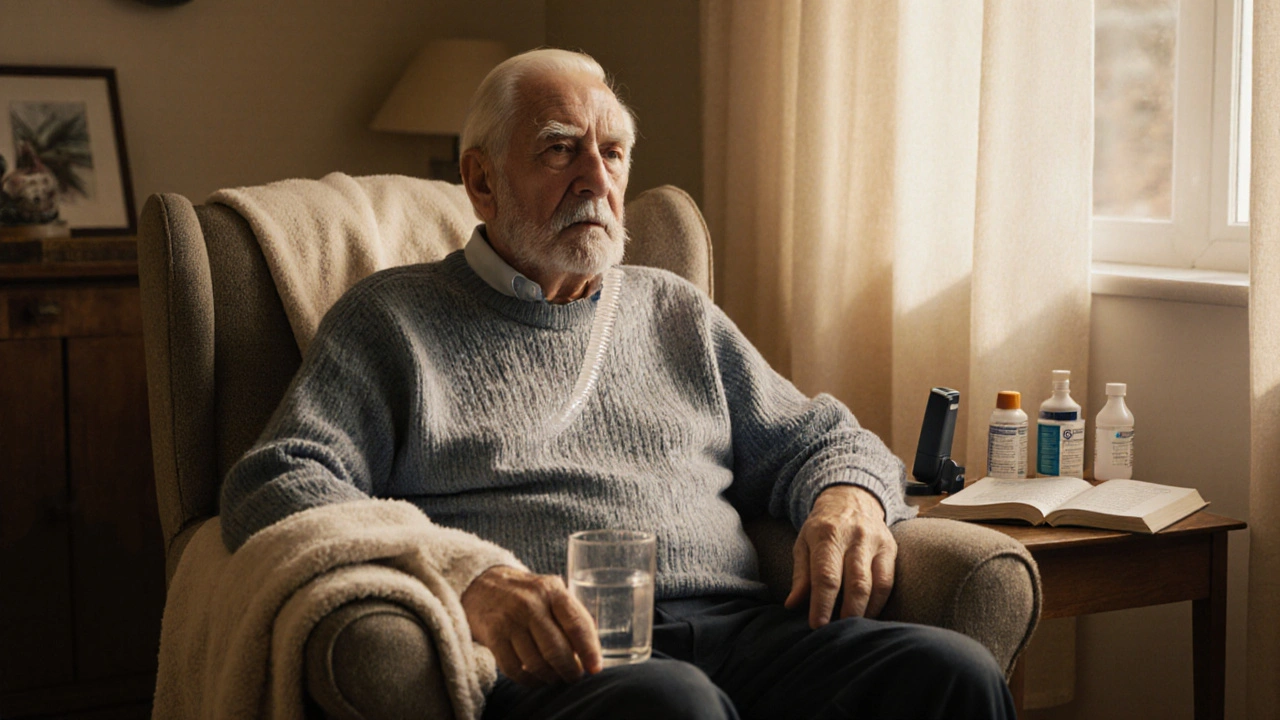IPF Symptom Relief Calculator
Select symptoms and severity level, then click "View Symptom Management Strategies" to see personalized recommendations.
Common IPF Symptoms & Interventions
Dyspnea
Breathlessness management with oxygen, medications, and pulmonary rehab.
Cough
Treatment with speech therapy, medications, and lifestyle adjustments.
Fatigue
Energy conservation, exercise, and nutritional support.
Anxiety/Depression
Therapy, mindfulness, medications, and support groups.
Nutrition Loss
Dietitian support, supplements, and meal planning.
Advance Care Planning
Documenting preferences and making informed decisions.
Living with idiopathic pulmonary fibrosis (IPF) feels like a constant battle against shortness of breath, relentless cough, and fatigue. When the disease starts to limit daily activities, many wonder how to keep life enjoyable and meaningful. The answer often lies in palliative care-a specialized approach that focuses on relief from symptoms, psychosocial support, and planning for the future.
Key Takeaways
- Palliative care is not only for end‑of‑life; it starts as soon as symptoms affect quality of life.
- IPF patients benefit from multidisciplinary teams that include pulmonologists, nurses, and mental‑health professionals.
- Early integration improves symptom control, reduces hospitalizations, and supports advance care planning.
- Accessing palliative services is possible through hospitals, community clinics, and telehealth platforms.
- Family caregivers receive education and respite, easing the emotional burden.
Understanding Idiopathic Pulmonary Fibrosis
Idiopathic Pulmonary Fibrosis is a chronic, progressive lung disease characterized by scarring (fibrosis) of the lung tissue without a known cause. Typical onset occurs after age 60, and the disease advances at a median rate of about 10% loss in lung function per year. Common symptoms include:
- Dyspnea on exertion
- Persistent dry cough
- Fatigue and weight loss
- Clubbing of fingers
Because the scarring is irreversible, treatment aims to slow progression (antifibrotic drugs such as nintedanib or pirfenidone) and manage symptoms. However, medication alone does not address the full impact on daily living.
What Is Palliative Care?
Palliative care is a holistic medical approach designed to relieve suffering and improve quality of life for patients with serious illnesses. It covers physical symptoms, emotional well‑being, spiritual concerns, and social support. Importantly, palliative care can be introduced at diagnosis and works alongside curative or disease‑modifying treatments.
The core principles include:
- Assessment and relief of pain, dyspnea, cough, and anxiety.
- Coordination among a multidisciplinary team.
- Clear communication about prognosis and treatment options.
- Support for caregivers and families.
- Advance care planning to honor patient preferences.

Why Palliative Care Is Crucial for IPF
IPF patients face a unique set of challenges that make palliative care especially valuable:
- Unpredictable disease trajectory. The rate of decline varies widely, leaving patients uncertain about future abilities.
- Severe breathlessness. Dyspnea often worsens before lung function tests show dramatic change, creating anxiety and activity avoidance.
- Limited treatment options. Antifibrotic drugs only slow progression; they do not reverse scarring.
- Psychosocial impact. Fear of oxygen dependence and loss of independence can lead to depression.
- Complex decision‑making. Choices about lung transplantation, clinical trials, or hospice require nuanced counseling.
When a palliative care team steps in early, they address each of these points, turning a frightening prognosis into a manageable reality.
How Palliative Care Improves Symptom Management
The following table matches common IPF symptoms with targeted palliative interventions. Note: All interventions are customizable based on patient preference and disease stage.
| Symptom | Palliative Intervention | Expected Benefit |
|---|---|---|
| Dyspnea | Low‑flow oxygen, fan therapy, pulmonary rehabilitation, opioids (e.g., low‑dose morphine) | Reduced breathlessness, increased ability to perform ADLs |
| Chronic Cough | Speech‑language therapy, low‑dose gabapentin, menthol cough drops | Fewer coughing episodes, better sleep |
| Fatigue | Energy‑conservation techniques, graded exercise, anemia screening | Improved stamina, less reliance on rest periods |
| Anxiety/Depression | Cognitive‑behavioral therapy, mindfulness, antidepressants, support groups | Enhanced mood, better coping with disease uncertainty |
| Nutrition Loss | Dietitian counseling, high‑protein supplements, small frequent meals | Stabilized weight, maintained muscle mass |
Building the Multidisciplinary Team
Effective palliative care for IPF hinges on collaboration among several specialists. Typical members include:
- Pulmonologist - oversees disease‑modifying therapy and monitors lung function.
- Specialized palliative‑care physician - leads symptom‑control strategies and advance‑care discussions.
- Respiratory therapist - teaches breathing techniques and oxygen equipment use.
- Physical / occupational therapist - designs activity‑preserving exercise plans.
- Psychologist or psychiatrist - addresses anxiety, depression, and coping mechanisms.
- Social worker - assists with insurance, financial resources, and caregiver respite.
- Dietitian - tailors nutrition plans to combat weight loss.
Most major hospitals in Australia, such as the Royal Melbourne Hospital, have dedicated lung‑disease palliative services. For patients in regional areas, telehealth consultations connect them with urban specialists while local community nurses provide home visits.
Advance Care Planning: Making Decisions Early
Advance care planning (ACP) is a cornerstone of palliative care. It involves documenting patient wishes regarding life‑sustaining treatments, preferred location of care, and designation of a healthcare proxy.
Key steps for IPF patients:
- Discuss prognosis openly with the pulmonologist and palliative‑care team.
- Identify the values that matter most-independence, time with family, avoidance of invasive ventilation.
- Complete an advance directive or statutory medical directive (Australia’s Medical Treatment Decision Maker form).
- Review and update the plan regularly as disease status changes.
When a crisis arises-such as an acute exacerbation-having an ACP in place reduces emergency‑room admissions and aligns care with the patient’s goals.

Accessing Palliative Care Services
Patients often wonder where to start. Here are practical pathways:
- Hospital referral. Ask your pulmonologist for a palliative‑care consult; many institutions have integrated clinics.
- Community health services. Local health districts (e.g., Melbourne Health) run home‑based palliative teams that can visit patients weekly.
- Private palliative‑care providers. Some private pulmonary specialists include palliative support as part of their practice.
- Telehealth platforms. Services like Telstra Health’s virtual palliative program offer video appointments, medication reviews, and remote monitoring.
Insurance coverage varies; Medicare’s Chronic Disease Management Plan often includes allied‑health visits, while the National Disability Insurance Scheme (NDIS) may fund additional support for eligible patients.
Supporting Caregivers
Family members frequently become the primary caregivers, managing oxygen tubing, medication schedules, and emotional reassurance. Palliative teams provide:
- Education on symptom‑recognition and when to call a clinician.
- Respite services-short‑term home‑care aides or day‑programs.
- Support groups (in‑person or online) that share coping strategies.
Caregiver well‑being directly influences patient outcomes; stressed caregivers are more likely to miss medication doses or delay seeking help during exacerbations.
Looking Ahead: Research and Emerging Options
While palliative care focuses on symptom relief, ongoing research aims to change the disease’s course. Current trials explore anti‑fibrotic combination therapies, gene‑editing approaches, and stem‑cell transplantation. Patients engaged in clinical trials benefit from close monitoring, often integrated with palliative support.
Staying informed about trial eligibility and emerging guidelines helps patients make proactive decisions, underscoring the partnership between research teams and palliative clinicians.
Frequently Asked Questions
Is palliative care only for the last weeks of life?
No. Palliative care can begin at diagnosis and run alongside disease‑modifying treatments. Early involvement helps control symptoms and plan for the future.
Can palliative care reduce hospital admissions for IPF?
Yes. Studies in Australian tertiary centres show a 30% drop in emergency visits when patients receive regular palliative follow‑up, mainly due to better symptom control and advance‑care planning.
What medications are used for breathlessness in IPF?
Low‑dose opioids (e.g., morphine 2.5mg oral every 4hours) are evidence‑based for refractory dyspnea. They are safe when monitored, and often combined with oxygen therapy and pulmonary rehab.
How can I start an advance care plan?
Talk to your pulmonologist about a palliative‑care referral. The palliative team will guide you through documenting preferences, appointing a medical decision‑maker, and reviewing the plan regularly.
Are there financial supports for home‑based palliative care?
Yes. Medicare’s Chronic Disease Management Plan covers allied‑health visits. Additionally, the NDIS can fund home‑care aides for eligible patients, and many charities provide equipment grants.


Shana Shapiro '19
October 11, 2025 AT 13:14I understand how overwhelming the breathlessness of IPF can feel, as if each inhalation is a battle against an unseen tide. The palliative‑care team steps in not as a sign of surrender, but as a compassionate ally that eases the weight of every gasp. By addressing pain, anxiety, and daily fatigue, they help you reclaim moments of joy that might otherwise be lost. This supportive approach can transform a life shadowed by disease into one still bright with purpose.
Jillian Bell
October 20, 2025 AT 05:34The pharmaceutical industry doesn't want you to hear about palliative care because it keeps patients dependent on costly, ongoing treatments. They push the narrative that “palliative means end‑of‑life” to maintain control, while the true philosophy is about empowering autonomy. When you question the motives behind glossy brochures, you see the hidden agenda: profit over relief. Embrace the alternative path that focuses on symptom mastery rather than corporate dictate.
Lindsey Bollig
October 28, 2025 AT 21:54Great rundown! Early palliative involvement can literally shorten hospital stays and boost quality of life for IPF folks. I always suggest patients start with a low‑flow oxygen trial plus a simple breathing exercise like pursed‑lip breathing. Pair that with a dietitian visit to keep weight steady, and you’ve got a solid baseline. Keep sharing this info – it really helps teammates navigate the tough decisions.
Daniel Buchanan
November 6, 2025 AT 14:14Teamwork is key here. Pulmonologists, therapists, and palliative specialists should meet regularly to review symptom scores and adjust plans. Encourage patients to voice what matters most – whether it’s staying on the porch or attending a family gathering. A coordinated approach prevents duplicated appointments and reduces stress. This mentorship mindset builds confidence across the care network.
Lena Williams
November 15, 2025 AT 06:34so i was scrolling through the ipf article and i cant help but notice how the palliative care section kinda glows like a beacon for folks feeling stuck. its like they finally admit that living with a chronic lung disease isnt just about meds but also about daily struggles that we all kinda overlook. i wonder how many patients actually get a referral before they hit the emergency room, cause that could change the whole vibe of their care. also, the mention of low‑dose morphine for breathlessness sounds wild but the studies back it up, which i find both comforting and a little scary. the whole multidisciplinary team idea sounds awesome, but i guess in rural areas getting a dietitian or a psychologist might be a real pain. maybe telehealth could bridge that gap, but then you need solid internet, which not everyone has. still, the push for advance care planning feels so important – it gives patients a voice when they might otherwise feel voiceless. overall, the article does a solid job, but i wish there were more personal stories to show the human side of all this. hope more clinicians read this and start passing the info along.
Sierra Bagstad
November 23, 2025 AT 22:54According to the latest ATS guidelines, early integration of palliative care in idiopathic pulmonary fibrosis reduces dyspnea scores by an average of 2.3 points on the Borg scale and decreases hospital readmission rates by approximately 28 %. The evidence base includes randomized controlled trials from 2019 and 2021 demonstrating significant improvements in health‑related quality of life metrics such as the King's Brief Interstitial Lung Disease questionnaire. Moreover, opioid‑based dyspnea management is endorsed when refractory to conventional measures, provided that dosing follows the WHO analgesic ladder. These data underscore the necessity of multidisciplinary collaboration for optimal patient outcomes.
Alan Kogosowski
December 2, 2025 AT 15:14When we examine the trajectory of idiopathic pulmonary fibrosis, it becomes evident that the disease follows a highly heterogeneous course, with some patients experiencing a relatively indolent decline while others confront rapid deterioration within a matter of months. This variability complicates clinical decision‑making, particularly regarding the timing of palliative‑care referral, which historically has been relegated to the final stages of illness. Contemporary literature, however, advocates for a paradigm shift whereby palliative services are engaged at the point of diagnosis, a notion supported by multiple cohort studies demonstrating reductions in emergency department visits and improvements in patient‑reported outcomes. The mechanisms underlying these benefits are multifactorial. First, specialist‑led symptom control-particularly for dyspnea-incorporates interventions such as low‑flow oxygen, fan therapy, and, when indicated, low‑dose morphine, each of which has been shown to alleviate the sensation of breathlessness without compromising respiratory function. Second, psychological support, delivered through cognitive‑behavioral therapy and mindfulness training, mitigates anxiety and depression, which are prevalent comorbidities that exacerbate the perception of physical symptoms. Third, nutritional counseling counteracts the catabolic state frequently observed in advanced fibrosis, preserving lean body mass and thereby enhancing functional capacity. In addition, the presence of an advance‑care planning framework empowers patients to articulate their preferences regarding life‑sustaining treatments, reducing the likelihood of invasive interventions that may not align with their values. This collaborative approach also eases the emotional burden on caregivers, who often report lower levels of stress when supported by a coordinated care team. From a health‑system perspective, integrating palliative care reduces unnecessary hospital admissions, translating into cost savings that can be reallocated to supportive services such as home‑based nursing or telehealth monitoring. It is worthwhile to note that telemedicine platforms have emerged as valuable conduits for delivering palliative interventions, especially for individuals residing in remote or underserved regions where access to specialist care is limited. Nonetheless, clinicians must remain vigilant to ensure equitable access, avoiding disparities that could arise from technology gaps. Ultimately, the synthesis of these elements illustrates that early palliative involvement is not merely an adjunct to disease‑modifying therapy but an essential component of a holistic treatment strategy that addresses the physical, emotional, and existential dimensions of living with IPF. By reframing palliative care as a proactive, rather than reactive, discipline, we can transform the patient experience from one characterized by inevitable decline to one that prioritizes dignity, comfort, and agency throughout the disease continuum.
Ben Lee
December 11, 2025 AT 07:34I think we can all agree that no single provider can cover every aspect of IPF care, which is why a team‑based approach feels like the most sensible route forward. When pulmonologists, palliative physicians, physiotherapists, and social workers sit down together, they can create a roadmap that reflects the patient’s goals-whether that’s maintaining independence at home or preparing for potential transplant evaluation. Sharing progress notes in a shared electronic health record helps avoid duplication and ensures everyone is on the same page. I’ve seen patients benefit immensely from simple breathing exercises taught by respiratory therapists, combined with targeted nutritional advice from dietitians, and that synergy often translates into fewer exacerbations. Let’s keep encouraging open communication among all parties, because the sum truly becomes greater than its parts.